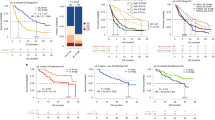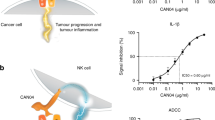Abstract
Interleukin 2 (IL-2) immunotherapy has met with limited success in the treatment of renal cell carcinoma (RCC) and malignant melanoma (MM). However, non-responders still account for up to 80% of those patients receiving IL-2. A high concentration of soluble IL-2 receptor (sIL-2R) is commonly found in the blood of such patients. We investigated the possibility that high sIL-2R concentration pretreatment may interfere with the bioavailability of IL-2. The mean concentration of sIL-2R in plasma from patients with MM, RCC and head and neck cancer was 3378 U ml-1, 8778 U ml-1 and 764 U ml-1 respectively, compared with 1315 U ml-1 in plasma from healthy volunteers. Inclusion of plasma from patients with RCC and MM patient plasma in cytotoxic T-lymphocyte leukaemic (CTLL) cell/IL-2 assays inhibited the ability of CTLL cells to respond to IL-2, and an inverse correlation was found between the concentration of sIL-2R and the growth response of CTLL cell to IL-2 (r = -0.86, P = 0.003). Plasma with soluble IL-2R concentrations greater than 3000 U ml-1 produced a reduction in cell growth of more than 50% when included in CTLL IL-2 assays. The addition of increasing concentrations of IL-2 to cultures containing suppressive plasma failed to restore CTLL cell growth response to normal. Failure to saturate sIL-2R by exogenous IL-2 addition therefore suggests that another factor, initially present at a concentration similar to the sIL-2R concentration, is responsible for the observed effect. Determination of the suppressive effect of patient plasma as presented here may allow more effective IL-2 dosing schedules.
This is a preview of subscription content, access via your institution
Access options
Subscribe to this journal
Receive 24 print issues and online access
$259.00 per year
only $10.79 per issue
Buy this article
- Purchase on Springer Link
- Instant access to full article PDF
Prices may be subject to local taxes which are calculated during checkout
Similar content being viewed by others
Author information
Authors and Affiliations
Rights and permissions
About this article
Cite this article
Gooding, R., Riches, P., Dadian, G. et al. Increased soluble interleukin-2 receptor concentration in plasma predicts a decreased cellular response to IL-2. Br J Cancer 72, 452–455 (1995). https://doi.org/10.1038/bjc.1995.354
Issue Date:
DOI: https://doi.org/10.1038/bjc.1995.354
This article is cited by
-
T Lymphocyte Characteristic Changes Under Serum Cytokine Deviations and Prognostic Factors of COVID-19 in Pregnant Women
Applied Biochemistry and Biotechnology (2023)
-
Immune system-related soluble mediators and COVID-19: basic mechanisms and clinical perspectives
Cell Communication and Signaling (2022)
-
Potential contribution of increased soluble IL-2R to lymphopenia in COVID-19 patients
Cellular & Molecular Immunology (2020)
-
Evaluation of the immunomodulatory effects of a South African commercial traditional immune booster in human peripheral blood mononuclear cells
BMC Complementary and Alternative Medicine (2016)
-
Anticancer immunotherapy by CTLA-4 blockade: obligatory contribution of IL-2 receptors and negative prognostic impact of soluble CD25
Cell Research (2015)



